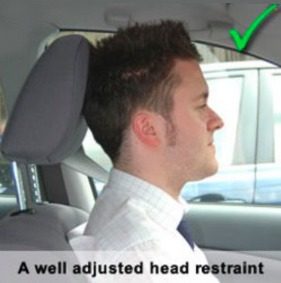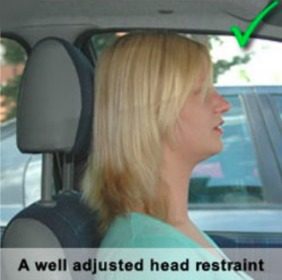I bet 9 out of 10 drivers have an incorrectly adjusted headrest.
Why is this important?
Because getting rear-ended is the most common type of car collision in the world. When you get rear-ended, your head is initially thrown backwards and your neck can be massively extended. Contrary to popular belief, your headrest isn’t there so you can snooze while stuck in traffic. Headrests are designed to protect your head from moving too much when you get rear-ended.
The problem is that most people don’t adjust the headrest at all, or if they do, they adjust it for comfort and not protection.
Chances are that you’ll be in at least one car crash in your life. (Statistics say you’ll be in a car accident every 18 years.) It’s time to do everything you can to protect yourself in advance. First, get adequate liability insurance. Then make sure you’re correctly using your car or truck’s safety features.
How to Adjust Your Headrest: Pull It Up
The seat headrest usually can be adjusted up and down (height) as well as tilt front and back. So how do you actually use these adjustments correctly? Adjust them so there is little to no space between the back of your head and the headrest. Most people I see have their headrests pushed all the way down to the seat. This is usually not only incorrect, but can actually cause you additional harm in a crash.
The first adjustment is the head height. You should sit in your seat as you normally do, then pull the headrest up so the top of it is as the top of your head. (The easiest way to do this is to have someone help you.) You might have to press a button on your headrest to adjust the height.
A high enough headrest will stop your head from forcefully jerking back during a collision. The cushion will do its job and protect you. If your headrest is too low, you could get whiplash or worse.

The picture above is how most people have their headrests; I bet yours is like this. This is bad and incorrect. If you imagine your head violently being forced back in a crash, you can see there is a lot of room for the head to whip backwards. Your head will touch the top of the headrest instead of the flat/front part it’s supposed to contact. This can cause more significant injures than the crash itself and is responsible for a lot of neck injuries. As you can see, this headrest needs to be pulled up at least six inches to the top of her head. This is why it is useful to have someone else help you do this in your car.
Move It Forward
The second adjustment you should make to your headrest is moving it forward so your head is right next to it. You should be able to rest your head on the headrest if you just push back slightly when driving. The correct adjustment is shown below:
It may seem unusual to drive like this at first, but it is the correct and safe way.
With the headrest adjusted to proper height and distance from the back of the head, you can see that it actually creates a cushioned wall against the back of your head. That is what they are designed to do. They are supposed to stop your head from whipping back at all. Below you can see why an improperly adjusted headrest creates space between the head and the headrest.
Having space between your head and the headrest (above) defeats the purpose. The height is correct in the photo above, but with a gap, your head can snap back and slam against it during a crash.
You can adjust this a few ways. First, the driver’s seat should not be reclined. These days, too many people slouch in their car. Instead, tilt your seat so it’s mostly vertical. Then your head will be closer to the headrest.
Second, most headrests also have a tilt adjustment that can angle the headrest toward your head more. Chances are that if the gap between your head and your headrest is like the one in the photo, your seat is reclined too much.
Conclusion
Try driving with your seat and headrest positioned properly for a week — I bet at the end of the week, your back will feel better. Plus, you’ll have peace of mind that you’re protecting yourself in the case of a rear-end collision and lessening your chances of a neck injury. Every single client of mine would pay all the money in the world if they could just not have been injured in a crash. Don’t find out the hard way that a little prevention can help you for the rest of your life.
If you’ve been in a car accident and need a lawyer, we always provide free consultations. Call or email us today.

Marty is a former criminal prosecutor in the Cascade County Attorney’s Office and now uses that experience to defend those accused of crimes. A University of Montana School of Law graduate, Marty focuses his practice on personal injury and criminal defense and is a premier DUI defense attorney. He is also well versed in the insurance claims industry and has negotiated significant settlements with nearly every major insurance company.




